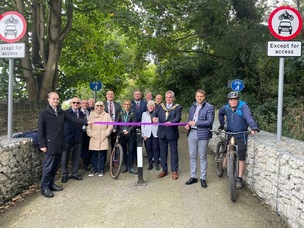BARNSLEY’S rich history will be honoured thanks to the installation of five new blue plaques - commemorating the work of the man who redesigned the town centre and the woman who brought the first department store specifically for women to the town.
Blue plaques are put up to recognise a building or place’s connection with a significant person from Barnsley or with an event in the history of the town.
The person might be a prominent individual in the history of the borough or someone whose achievements are more widely known.
Some blue plaques have also been erected to commemorate events which took place at the location rather than the people who lived, worked or studied there.
There are currently a total of 20 blue plaques - as well as the recently-unveiled Michael Parkinson plaque which was fast-tracked and placed at the Dorothy Hyman Stadium.
Other plaques include Grimethorpe Colliery Band, George Orwell and three for Joseph Locke which are placed at the Cooper Gallery, Shambles Street and Locke Park.
The Barnsley Civic Trust has been working with the High Street Heritage Action Zone on Eldon Street which agreed to fund five new blue plaques to tell different stories of Eldon Street - two of which are set to be unveiled on July 9.
Ann Porter
Ann was the founder of A Porter’s and Sons, one of Barnsley’s first department stores catering specifically to women.
A Barnsley Museums spokesperson said: “Rather than inheriting a family business, Ann is unusual in that she set up her business after her husband, Benjamin Porter - a gas maker, died in the 1870s.
“By the 1881 census, Ann is recorded as a widow with a shop on Sheffield Road.
“She moved the business to larger premises at 58 Eldon Street - now Leslie Francis hairdressers - in 1896.”
Her blue plaque is set to be unveiled next month.
John Whitworth
Eldon Street was first laid out in 1840 by architect and surveyor John Whitworth.
“Whitworth was responsible for a programme of ‘improvements’ to Barnsley town centre, following an Act of Parliament in 1822.
“Eldon Street was one of a number of new, wide streets created by John Whitworth around the earlier medieval town core, including Pitt Street and Wellington Street (in 1815) and Peel Street (in 1830).”
His plaque will be placed on 14 Regent Street, where he lived and subsequently died.
Catherine Mawer
Catherine was a stonemason who produced the carved heads and stonework on the Queen’s Hotel, which was on Regent Street.
The heads include Queen Victoria, the first two Barnsley mayors, Catherine herself and one of her pupils, Benjamin Payler.
A spokesperson for the Barnsley Civic Trust said: “The blue Pplaque proposed to be fixed to the Queen’s Hotel (now Queen’s Court Business Centre) commemorates Catherine Mawer whose studio produced the carved heads and artistic masonry on the Queen’s Hotel.
“The carved heads include not only Queen Victoria but also the first two mayors of Barnsley, and both Catherine Mawer and Benjamin Payler.
“Their contribution to the artistry of the Queen’s Hotel and Barnsley’s heritage deserves to be commemorated.”
Thomas Lister
Thomas Lister was both a poet and naturalist and contributed many articles on birds and weather to the Barnsley Chronicle.
He was for a long time the president of the Barnsley Naturalists’ Society.
He was closely involved in the early years of the Mechanic’s Institute - now Barnsley Civic - and his work will be commemorated in the near future.
His work was recently picked up by poet Simon Armitage.
Century of entertainment at Parkway Cinema site
Since 1908, there has been an entertainment venue on the site of the Parkway Cinema on Eldon Street, starting with The Empire Palace of Varieties Theatre which was also home to a school of performing sea lions in 1911.
The theatre was then turned into The Empire Super Cinema in 1920 with sound being installed in 1929, the cinema was renamed The Gaumont in 1950 and despite a fire that saw the building destroyed, it was rebuilt and reopened in 1956.
It was then an Odeon from 1960 until it closed in 2005 before being bought by Rob Younger and Gerald Parkes in 2007.
Research by the HSHAZ shows that this patch of ground on Eldon Street has attracted the performing and theatrical arts longer than first thought with at least two temporary wooden venues in place in the 1800s.




























